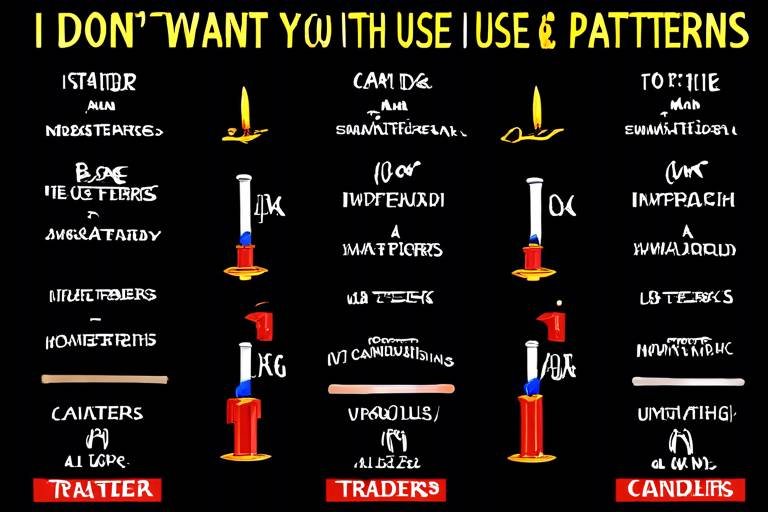Creating a Step-by-Step Trading Plan
Welcome to the exciting world of trading! If you've ever felt overwhelmed by the sheer volume of information out there, you're not alone. But fear not! This article serves as a comprehensive guide on how to develop an effective trading plan, detailing each step and its importance in achieving trading success. Think of your trading plan as your personal GPS; it helps you navigate the unpredictable terrain of the financial markets, ensuring you stay on course toward your goals.
Many traders dive into the markets without a clear plan, often leading to confusion and losses. A well-structured trading plan not only guides your decisions but also instills a sense of discipline and consistency. Imagine trying to build a house without a blueprint; it would be chaotic, right? Similarly, a trading plan lays down the foundation for your trading activities, helping you avoid impulsive decisions driven by emotions.
In this article, we'll break down the essential components of a trading plan step-by-step. From defining your trading goals to understanding risk management strategies and choosing your trading style, we’ll cover it all. You’ll learn how to create a roadmap that aligns with your personal objectives, ensuring that every trade you make is a step towards achieving your financial aspirations.
So, are you ready to embark on this journey? Let’s dive in and explore how you can create a trading plan that not only reflects your unique style and goals but also positions you for long-term success in the trading arena.
A trading plan serves as a roadmap for traders, helping them make informed decisions and manage risks effectively. It emphasizes the significance of discipline and consistency in trading. Without a plan, it's easy to get swept away by market fluctuations, leading to hasty decisions that can result in substantial losses. Think of a trading plan as your safety net; it catches you when you’re about to fall into the abyss of emotional trading.
Moreover, having a trading plan allows you to set clear parameters for entering and exiting trades, which can significantly enhance your performance. By establishing rules for yourself, you create a structured approach that helps eliminate guesswork and encourages you to stick to your strategy, no matter how tempting it may be to deviate during volatile market conditions.
Setting clear and achievable trading goals is crucial. This section discusses how to identify personal objectives and align them with your trading strategy for better focus and motivation. When you know what you want to achieve, it becomes easier to develop a plan that directs your efforts toward those specific outcomes. Ask yourself: What do I want from trading? Is it financial independence, a supplemental income, or simply the thrill of the trade?
Understanding the difference between short-term and long-term trading goals can greatly impact your strategy. Short-term goals might include making a certain number of profitable trades each week, while long-term goals could involve building a sustainable income over several years. Balancing both types of goals is essential; it keeps you grounded while also allowing you to dream big.
Utilizing the SMART criteria—Specific, Measurable, Achievable, Relevant, Time-bound—can enhance goal-setting effectiveness. For example, instead of saying, “I want to make money trading,” a SMART goal would be, “I want to achieve a 10% return on my trading account within six months.” This clarity not only helps you track your progress but also keeps you motivated.
As market conditions change, so should your trading goals. This part covers how to reassess and modify goals to stay aligned with your trading journey. Regularly reviewing your goals allows you to adapt to new challenges and opportunities in the market. Just like a sailor adjusts their sails according to the wind, you must be willing to tweak your goals to ensure you stay on course.
Effective risk management is vital for long-term trading success. This section outlines various strategies to protect your capital and minimize losses. Think of risk management as the armor that protects you in the battlefield of trading. It’s essential to determine how much of your capital you are willing to risk on each trade. A common rule is to risk no more than 1-2% of your trading account on a single trade. This way, even a series of losses won't significantly dent your capital.
Selecting a trading style that suits your personality and goals is essential. This part examines different trading styles, including day trading, swing trading, and position trading. Each style has its unique characteristics and requires different levels of commitment and risk tolerance.
Day trading involves making multiple trades within a single day. This subsection discusses the key factors to consider for successful day trading. It requires quick decision-making, a solid understanding of market trends, and the ability to manage emotions effectively. If you thrive in fast-paced environments and enjoy the thrill of the chase, day trading might be your cup of tea.
Position trading focuses on long-term market trends. This segment highlights the advantages and challenges of adopting a position trading approach. It’s ideal for those who prefer a more relaxed trading style, allowing you to hold onto positions for weeks or even months. However, patience is key, as this approach requires a deep understanding of market fundamentals and the ability to weather short-term volatility.
- What is a trading plan? A trading plan is a comprehensive strategy that outlines your trading goals, risk management strategies, and the specific methods you will use to achieve success in the markets.
- Why is risk management important? Risk management is crucial because it helps protect your capital from significant losses and ensures long-term sustainability in trading.
- How do I choose a trading style? Your trading style should align with your personality, lifestyle, and financial goals. Consider how much time you can dedicate to trading and your risk tolerance.

Understanding the Importance of a Trading Plan
A trading plan is not just a fancy document; it’s your personal roadmap to success in the financial markets. Imagine setting off on a road trip without a map or GPS—sounds chaotic, right? The same principle applies to trading. Without a clear plan, you might find yourself lost in the whirlwind of market fluctuations, emotional decisions, and impulsive trades. A well-structured trading plan helps you navigate these challenges, ensuring that you make informed decisions based on logic rather than emotion.
One of the key benefits of having a trading plan is that it instills a sense of discipline. In the fast-paced world of trading, it’s easy to get swept away by excitement or fear. A solid plan encourages you to stick to your strategy, minimizing the chances of making rash decisions that could lead to significant losses. It acts as a shield against the emotional rollercoaster that many traders experience, allowing you to maintain a level head even in turbulent times.
Moreover, a trading plan is essential for effective risk management. It allows you to set clear parameters for your trades, including entry and exit points, as well as stop-loss levels. This structured approach not only helps you protect your capital but also enhances your overall trading performance. To illustrate this, consider the following table that outlines the key components of a trading plan:
| Component | Description |
|---|---|
| Trading Goals | Define what you want to achieve, whether it’s short-term gains or long-term growth. |
| Market Analysis | Outline your approach to analyzing market trends and making predictions. |
| Risk Management | Establish rules for managing risk, including position sizing and stop-loss orders. |
| Performance Evaluation | Set criteria for reviewing and adjusting your trading strategies over time. |
Finally, having a trading plan fosters consistency. It allows you to track your progress and identify what works and what doesn’t. By sticking to your plan, you can refine your strategies based on actual performance rather than guesswork. Think of it as a recipe: if you follow it closely, you’re more likely to bake a delicious cake. Deviate from it, and you might end up with a burnt disaster!
In summary, a trading plan is your best ally in the quest for trading success. It provides clarity, discipline, and a structured approach to navigating the unpredictable waters of the financial markets. So, before you dive in, take the time to create a comprehensive trading plan that aligns with your personal goals and risk tolerance.
- What should I include in my trading plan? Your trading plan should include your trading goals, market analysis methods, risk management strategies, and a system for evaluating your performance.
- How often should I review my trading plan? It's advisable to review your trading plan regularly, especially after significant market changes or personal trading experiences.
- Can I change my trading plan? Absolutely! Your trading plan should evolve as your goals, experience, and market conditions change.

Defining Your Trading Goals
Setting clear and achievable trading goals is absolutely crucial for anyone venturing into the world of trading. Think of your trading goals as the compass guiding you through the unpredictable seas of the financial markets. Without a compass, you might find yourself lost, wandering aimlessly, and potentially making costly mistakes. By defining your objectives, you not only gain clarity but also a sense of direction that will keep you focused and motivated.
First off, it’s important to identify what you truly want to achieve with your trading endeavors. Are you looking to build wealth over time, or are you aiming for quick profits? Perhaps you want to supplement your income or even replace your full-time job. Whatever your aspirations may be, aligning them with your trading strategy is essential for maintaining focus. When you have a clear vision, it becomes easier to develop a plan that suits your needs and desires.
Moreover, it’s beneficial to break down your goals into smaller, more manageable pieces. This approach not only makes your objectives feel less daunting but also allows you to celebrate small victories along the way. For instance, you might set a short-term goal of achieving a specific percentage return on your investment within a month, while your long-term goal could be to double your trading capital within a year. By setting both short-term and long-term goals, you create a balanced approach that keeps you engaged and motivated.
Understanding the difference between short-term and long-term trading goals can significantly impact your overall strategy. Short-term goals are typically more immediate and can be achieved within weeks or months. They are often focused on specific trades or performance metrics, such as achieving a certain percentage gain or reducing losses. On the other hand, long-term goals are broader and may involve overall portfolio growth or establishing a sustainable trading practice over several years.
Balancing both types of goals is crucial. For instance, while you may want to make quick gains in the short term, it’s essential to keep your long-term objectives in mind to avoid making impulsive decisions that could derail your overall strategy. Consider this: if you’re only focused on short-term profits, you might engage in risky trades that could jeopardize your long-term success. Hence, a well-rounded approach that incorporates both short-term and long-term goals will yield optimal results.
One effective way to enhance your goal-setting process is by utilizing the SMART criteria—Specific, Measurable, Achievable, Relevant, and Time-bound. This framework ensures that your goals are well-defined and realistic. For example, instead of saying, “I want to make money trading,” a SMART goal would be, “I aim to achieve a 10% return on my investment within the next three months by trading in the tech sector.”
Here’s how to break it down:
- Specific: Clearly define what you want to achieve.
- Measurable: Ensure you can track your progress.
- Achievable: Set realistic goals based on your skills and market conditions.
- Relevant: Align your goals with your overall trading strategy.
- Time-bound: Set a deadline to create urgency.
As you navigate the ever-changing landscape of the financial markets, it’s vital to reassess and modify your trading goals. Market conditions can shift dramatically, and what worked yesterday might not work today. By regularly reviewing your goals, you ensure they remain aligned with your trading journey and current market dynamics.
For instance, if you initially set a goal based on a bullish market trend and suddenly the market turns bearish, it may be necessary to adjust your expectations and strategies accordingly. This flexibility will not only help you stay relevant but also protect your capital from unnecessary risks. Remember, trading is as much about adaptation as it is about planning.
Q: How often should I review my trading goals?
A: It’s advisable to review your trading goals at least quarterly, or whenever there are significant changes in market conditions or your personal circumstances.
Q: Can I have multiple trading goals?
A: Absolutely! Having multiple goals, both short-term and long-term, can help you stay focused and motivated, as long as they are aligned with your overall trading strategy.
Q: What if I don't meet my trading goals?
A: Don’t be discouraged. Use it as a learning opportunity to analyze what went wrong and adjust your strategy accordingly. Remember, trading is a journey, not a sprint!

Short-Term vs. Long-Term Goals
When it comes to trading, understanding the difference between short-term and long-term goals is crucial for developing an effective strategy. Think of it like planning a road trip: you need to know your destination (long-term goals) but also the stops along the way (short-term goals) to ensure you reach your final destination smoothly. Short-term goals often focus on quick wins, such as making a specific profit within a week or capitalizing on market fluctuations. These goals are usually more tactical and can help you build momentum and confidence as you navigate the fast-paced trading environment.
On the other hand, long-term goals are more like the grand vision of your trading journey. They might include objectives like achieving a certain net worth or developing a sustainable income from trading over several years. Long-term goals require patience and a solid understanding of market trends, as they often involve holding positions for extended periods. Balancing these two types of goals is essential; while short-term goals can provide immediate gratification and motivation, long-term goals offer a broader perspective and help you stay focused on your overall strategy.
To effectively balance short-term and long-term goals, consider the following:
- Clarity: Be clear about what you want to achieve in both the short and long run.
- Alignment: Ensure that your short-term goals support your long-term aspirations.
- Flexibility: Be willing to adjust your short-term strategies based on market conditions while keeping your long-term vision in mind.
For instance, if your long-term goal is to retire early through trading, your short-term goals could involve achieving a specific monthly return that compounds over time. This way, each small success contributes to your larger objective, making the journey less daunting and more rewarding.
In summary, striking a balance between short-term and long-term goals is not just a good idea; it's a necessity. By keeping your eye on the horizon while also enjoying the view along the way, you can create a more fulfilling and successful trading experience.

SMART Goals Framework
When it comes to trading, having a clear direction is essential, and that's where the SMART goals framework comes into play. This method helps you set goals that are not just wishful thinking but are grounded in reality, making your trading journey more structured and focused. So, what does SMART stand for? It’s an acronym for Specific, Measurable, Achievable, Relevant, and Time-bound. Let’s break it down.
Specific: Your goals should be clear and specific so that you know exactly what you are aiming for. Instead of saying, "I want to make money trading," you could say, "I want to earn $500 a month from trading." This clarity helps you focus your efforts.
Measurable: It’s important to have measurable goals so you can track your progress. For instance, if your goal is to increase your trading account by 20% in six months, you can easily measure whether you’re on track or need to adjust your strategy.
Achievable: While it’s great to be ambitious, your goals should also be realistic. Setting a goal to turn a $1,000 investment into $100,000 in a month is likely not achievable. Instead, aim for a more realistic increase based on your trading experience and market conditions.
Relevant: Your goals should align with your overall trading strategy and personal circumstances. If you’re a beginner, a relevant goal might be to learn one new trading strategy per month, rather than trying to master multiple strategies all at once.
Time-bound: Lastly, setting a deadline for your goals is crucial. It creates a sense of urgency and helps you stay focused. For example, you might set a goal to achieve a certain profit margin by the end of the quarter. This time frame encourages you to take action and evaluate your results regularly.
To illustrate how SMART goals can be applied in trading, here’s a simple table:
| SMART Criteria | Example Goal |
|---|---|
| Specific | Earn $500 a month from trading |
| Measurable | Increase trading account by 20% in six months |
| Achievable | Realistically make 5% profit per month |
| Relevant | Learn one new trading strategy each month |
| Time-bound | Achieve goal by the end of Q2 |
By applying the SMART framework to your trading goals, you’re not just setting yourself up for potential success; you’re also cultivating a disciplined approach that can help you navigate the often volatile trading landscape. Remember, the key is to regularly review and adjust your goals as needed to stay aligned with your trading journey. Are you ready to make your trading ambitions a reality?
1. What if I don't meet my SMART goals?
It's completely normal to miss a goal or two. The important thing is to analyze why you didn't achieve it and adjust your strategy. Learning from setbacks is a crucial part of becoming a successful trader.
2. How often should I revisit my trading goals?
It's advisable to review your goals at least once a month. This allows you to stay on track and make necessary adjustments based on market conditions and your personal progress.
3. Can I have multiple SMART goals at once?
Absolutely! Just ensure that they are manageable and do not overwhelm you. Focus on a few key goals that align with your trading strategy and personal growth.

Adjusting Goals Over Time
In the ever-changing landscape of trading, adaptability is key. Just like a ship must adjust its sails to navigate through shifting winds, you too must be willing to alter your trading goals as market conditions evolve. Imagine setting out on a road trip without a GPS; you might have a destination in mind, but unexpected detours can lead you astray. This is why regularly reassessing your goals is not just beneficial—it’s essential for staying on course.
As you gain experience in trading, your understanding of the market deepens, and your initial goals may no longer align with your current situation or aspirations. For instance, you might start trading with the goal of making a quick profit, but as you learn more about the market's complexities, you may find that you want to focus on long-term growth instead. This shift is completely normal and reflects your evolving trading philosophy.
To effectively adjust your goals, consider the following steps:
- Regularly Review Your Performance: Set aside time each month to analyze your trading outcomes. Are you meeting your goals? If not, why? This reflection can provide insights into whether your objectives need tweaking.
- Stay Informed: Keep an eye on market trends and news. Changes in the economic climate can impact your trading strategy, necessitating a reevaluation of your goals.
- Seek Feedback: Engage with other traders or mentors. They can offer valuable perspectives that might highlight areas where your goals could be more realistic or ambitious.
Moreover, it’s important to remember that adjusting your goals doesn’t mean abandoning them. Instead, think of it as a way to refine your focus. For example, if you initially aimed for a 20% return on investment but found that market conditions make this unrealistic, consider adjusting your goal to a more attainable 10% while still pushing yourself to improve your skills and strategies.
Another useful technique is to implement a goal-tracking system. This could be as simple as a spreadsheet where you log your objectives, the reasons behind any adjustments, and your progress over time. By visualizing your journey, you can better understand how your goals evolve and how they align with your trading strategy.
In summary, adjusting your trading goals over time is not just a necessity; it’s a vital component of your growth as a trader. By staying flexible and responsive to changes in the market and your personal circumstances, you can maintain a clear direction and continue making informed decisions that enhance your trading success.
1. Why should I adjust my trading goals?
Adjusting your trading goals is crucial because market conditions and personal circumstances can change. Regularly reassessing your goals ensures they remain relevant and achievable.
2. How often should I review my trading goals?
It’s recommended to review your trading goals at least once a month, but you can do so more frequently if you notice significant changes in your trading performance or market conditions.
3. What should I do if I find my goals are too ambitious?
If your goals seem too ambitious, consider scaling them back to something more achievable. This doesn’t mean you should lower your standards, but rather that you should set realistic benchmarks that allow for steady progress.
4. Can I change my trading style while adjusting my goals?
Absolutely! In fact, changing your trading style may necessitate a reassessment of your goals. As you shift your approach, ensure your objectives align with your new strategy.

Risk Management Strategies
When it comes to trading, the phrase "don't put all your eggs in one basket" couldn't be more relevant. Effective are the backbone of successful trading. They not only protect your capital but also provide you with the confidence to make informed decisions. Imagine you're navigating through a stormy sea; without a sturdy boat and a solid plan, you're likely to capsize. Similarly, having a robust risk management strategy can keep you afloat in the volatile waters of the financial markets.
First and foremost, it's essential to understand your risk tolerance. This involves knowing how much of your capital you're willing to risk on a single trade. A common rule of thumb is to risk no more than 1-2% of your total trading capital on any given trade. This way, even a string of losses won’t sink your entire trading account. For instance, if you have a trading account of $10,000, risking 1% means you would only lose $100 per trade. This approach helps in maintaining a long-term perspective and avoids emotional trading decisions.
Another critical aspect of risk management is the use of stop-loss orders. These are predetermined price points at which you will exit a losing trade to prevent further losses. Think of stop-loss orders as your safety net; they ensure that you don't lose more than you're comfortable with. For example, if you buy a stock at $50 and set a stop-loss at $48, your maximum loss is capped at $2 per share. This strategy allows you to trade with a clear exit strategy, reducing anxiety and keeping your emotions in check.
Additionally, diversifying your portfolio can significantly mitigate risk. By spreading your investments across different asset classes—such as stocks, bonds, and commodities—you can reduce the impact of a poor-performing investment on your overall portfolio. Imagine a fruit basket; if one fruit spoils, the others remain fresh. Similarly, diversification helps in preserving your capital even when some trades don’t go as planned.
Furthermore, position sizing is a crucial element of your risk management strategy. This involves determining the number of shares or contracts to buy based on your risk tolerance and the distance to your stop-loss level. Using the formula:
| Formula | Description |
|---|---|
| Position Size (Account Risk Amount) / (Trade Risk per Share) | This formula helps you calculate how many shares to buy based on your risk tolerance and stop-loss distance. |
For example, if your account risk amount is $100 and your stop-loss is $2 away from your entry point, you would buy 50 shares. This ensures that your potential loss remains within your comfort zone.
Lastly, regularly reviewing and adjusting your risk management strategies is vital. The markets are constantly changing, and what worked yesterday might not work today. By staying adaptable and reassessing your strategies, you can ensure that you are always prepared for whatever the market throws your way. Think of it as tuning a musical instrument; regular adjustments keep your performance in harmony.
- What is the most important aspect of risk management?
Understanding your risk tolerance is crucial as it helps you make informed decisions on how much to risk on each trade. - How can I effectively use stop-loss orders?
Set stop-loss orders at a price point that limits your loss to a predetermined amount, based on your risk tolerance. - Is diversification necessary in trading?
Yes, diversification helps spread risk across different assets, reducing the impact of any single investment's poor performance. - How often should I review my risk management strategies?
Regularly reviewing your strategies—at least quarterly or after significant market changes—ensures they remain effective.

Choosing Your Trading Style
Choosing the right trading style is akin to finding the perfect pair of shoes; it needs to fit your personality, goals, and lifestyle. Just as you wouldn’t wear hiking boots to a formal event, you shouldn’t adopt a trading style that doesn’t resonate with who you are as a trader. There are several trading styles out there, each with its own unique characteristics and demands. Understanding these styles can help you make an informed decision that aligns with your objectives, risk tolerance, and time commitment.
Let’s break down some of the most popular trading styles:
- Day Trading: This style involves making multiple trades within a single day, aiming to capitalize on short-term price movements. Day traders need to be highly attentive and quick on their feet, as they often make decisions based on real-time market data. It's a fast-paced environment that requires discipline and a solid understanding of technical analysis.
- Swing Trading: Unlike day traders, swing traders hold positions for several days or weeks to take advantage of expected upward or downward market shifts. This style is perfect for those who can’t dedicate their entire day to trading but still want to benefit from market fluctuations. Swing traders often rely on both technical and fundamental analysis to make informed decisions.
- Position Trading: This approach is more long-term, focusing on major trends over weeks, months, or even years. Position traders typically conduct thorough research and analysis before entering a trade, making this style suitable for those who prefer a less hands-on approach. It’s about patience and a strong belief in your analysis.
Each trading style has its own set of advantages and challenges. For instance, day trading can offer quick returns but also comes with higher risks and requires constant monitoring of the markets. On the other hand, position trading may not yield immediate results, but it allows for a more relaxed trading experience. The key is to find a style that not only aligns with your financial goals but also fits your personality.
Another important factor to consider is your time commitment. If you have a full-time job or other responsibilities, a style like swing or position trading might be more suitable. Conversely, if you have the time and the desire for the adrenaline rush that comes with day trading, then that could be the right fit for you. It’s essential to assess how much time you can realistically dedicate to trading without compromising other aspects of your life.
In conclusion, choosing your trading style is an essential step in your trading journey. It’s not just about the potential for profit; it’s about finding a method that you can stick with long-term. Remember, the best trading style is one that aligns with your personal goals, risk tolerance, and lifestyle. So, take your time, do your research, and make a choice that feels right for you.
- What is the best trading style for beginners? Beginners often find swing trading to be more manageable as it allows for more time to make decisions and learn the ropes without the pressure of day trading.
- Can I switch trading styles later on? Absolutely! As you gain more experience and your personal circumstances change, you can adapt your trading style to better suit your evolving goals and market conditions.
- How do I determine my risk tolerance? Assess your financial situation, investment goals, and emotional response to losses to gauge your risk tolerance. It’s important to be honest with yourself about how much risk you can handle.
- Is it possible to combine different trading styles? Yes, many traders find success by combining elements from various styles. For example, a trader might use day trading strategies for short-term opportunities while maintaining a position trading approach for long-term holdings.

Day Trading Essentials
Day trading is an exhilarating journey that many traders embark upon, where the thrill of buying and selling stocks happens within the same day. It’s not just about making quick profits; it’s a blend of strategy, discipline, and timing. To succeed in this fast-paced environment, you need to grasp several essential components that can make or break your trading career.
First and foremost, understanding market trends is crucial. You don’t want to jump into trades blindly. Instead, keep an eye on the overall market direction, whether it’s bullish or bearish. Utilizing tools like moving averages, trend lines, and candlestick patterns can help you visualize these trends and make informed decisions. Remember, the market can be as unpredictable as a roller coaster ride, so having a clear view of where it’s headed is vital.
Next, let’s talk about setting a trading plan. Just like a pilot wouldn’t take off without a flight plan, you shouldn’t trade without a well-defined strategy. This plan should include your entry and exit points, risk-reward ratios, and daily profit targets. A simple table can help you outline your trading plan:
| Element | Description |
|---|---|
| Entry Point | Price at which you will buy the stock |
| Exit Point | Price at which you will sell the stock |
| Risk-Reward Ratio | Ratio of potential profit to potential loss |
| Daily Profit Target | Amount you aim to earn each trading day |
Moreover, risk management cannot be overlooked. It’s the safety net that protects your capital. A common rule of thumb is to never risk more than 1-2% of your trading capital on a single trade. This way, even if a few trades go against you, your account won’t take a massive hit. Think of it as wearing a seatbelt in a car; it won’t prevent accidents, but it will protect you from severe consequences.
Another essential aspect of day trading is choosing the right tools. A robust trading platform with real-time data, advanced charting tools, and fast execution speeds can significantly enhance your trading experience. Additionally, consider using a reliable news feed to stay updated on market-moving events. Information is power in day trading, and being the first to react can give you a competitive edge.
Lastly, let’s not forget the importance of emotional discipline. Day trading can be an emotional roller coaster, with the potential for significant gains or losses. It’s crucial to keep your emotions in check and stick to your trading plan. If you find yourself becoming too greedy or fearful, take a step back. Remember, it’s not about winning every trade; it’s about making consistent profits over time.
In conclusion, day trading is not for the faint of heart, but with the right knowledge and tools, it can be a rewarding venture. By understanding market trends, setting a solid trading plan, managing your risks, utilizing the right tools, and maintaining emotional discipline, you’ll be well on your way to becoming a successful day trader.
- What is day trading? Day trading involves buying and selling financial instruments within the same trading day, aiming to profit from short-term market movements.
- Do I need a lot of money to start day trading? While having a larger capital can provide more flexibility, you can start day trading with a smaller amount, especially with the advent of commission-free trading platforms.
- How do I choose a trading platform? Look for platforms that offer low fees, user-friendly interfaces, and robust trading tools that suit your trading style.
- Can I make a living from day trading? Yes, but it requires significant knowledge, experience, and discipline. Many traders start part-time while learning the ropes.

Position Trading Insights
Position trading is a fascinating approach that allows traders to hold positions for extended periods, often weeks, months, or even years. This style is particularly appealing to those who prefer to avoid the stress of daily trading and are looking for a more relaxed trading environment. Imagine planting a seed and nurturing it over time until it blossoms; position trading embodies this concept. It requires patience, a keen understanding of market trends, and the discipline to withstand the ups and downs of the market.
One of the primary advantages of position trading is its focus on long-term trends. Traders in this category typically analyze fundamental factors and broader economic indicators rather than getting bogged down by short-term price fluctuations. This means that position traders often rely on in-depth research and analysis to make informed decisions. For instance, they may look at factors such as earnings reports, economic data releases, and geopolitical events that can affect the market over time.
However, position trading isn’t without its challenges. The longer you hold a position, the more exposure you have to market volatility. This is where effective risk management becomes crucial. Position traders need to set appropriate stop-loss orders to protect against significant downturns. Additionally, they should regularly review their positions to ensure that their initial analysis remains valid. It’s not uncommon for market conditions to change, and what seemed like a solid investment can turn sour if not monitored closely.
To help illustrate the potential benefits and challenges of position trading, consider the following table that outlines key characteristics:
| Characteristic | Position Trading |
|---|---|
| Time Horizon | Weeks to years |
| Market Analysis | Fundamental analysis focused on long-term trends |
| Risk Management | Use of stop-loss orders and regular reviews |
| Emotional Stress | Lower stress compared to day trading |
| Capital Requirement | Can vary based on strategy and market conditions |
In summary, position trading can be a rewarding strategy for those willing to commit to a longer-term outlook. It encourages traders to think critically about their investments and to develop a thorough understanding of the markets. If you’re someone who enjoys research and analysis, and you have the patience to wait for your investments to mature, position trading might just be the perfect fit for you.
- What is the main difference between position trading and day trading?
Position trading focuses on long-term trends, while day trading involves making multiple trades within a single day. - How do I choose the right stocks for position trading?
Look for companies with strong fundamentals, consistent earnings growth, and positive industry trends. - Is position trading suitable for beginners?
Yes, as it allows beginners to learn about the market without the pressure of frequent trading. - What tools can help with position trading?
Charting software, economic calendars, and financial news sources are essential tools for position traders.
Frequently Asked Questions
- What is a trading plan?
A trading plan is a comprehensive strategy that outlines how a trader intends to operate in the financial markets. It includes rules for entering and exiting trades, risk management strategies, and overall trading goals. Think of it as a roadmap that guides you through the ups and downs of trading.
- Why is having a trading plan important?
Having a trading plan is crucial because it helps you make informed decisions rather than relying on emotions. It promotes discipline and consistency, allowing you to manage risks effectively and stay focused on your goals, even when the market gets volatile.
- How do I define my trading goals?
Defining your trading goals involves identifying what you want to achieve through trading. Start by asking yourself questions like: What are my financial objectives? How much time can I dedicate to trading? Setting clear and achievable goals gives you direction and motivation.
- What are SMART goals in trading?
SMART goals are Specific, Measurable, Achievable, Relevant, and Time-bound. This framework helps you set clear and actionable trading goals. For example, instead of saying "I want to make money," a SMART goal would be "I aim to achieve a 10% return on my investment within the next three months."
- How should I adjust my trading goals over time?
Your trading goals should evolve as market conditions change and as you gain more experience. Regularly reassess your goals to ensure they align with your current trading strategy and market environment. This flexibility can help you stay on track and adapt to new challenges.
- What are some effective risk management strategies?
Effective risk management strategies include setting stop-loss orders, diversifying your portfolio, and only risking a small percentage of your capital on each trade. These strategies help protect your capital and minimize potential losses, allowing you to trade with confidence.
- What trading style should I choose?
Choosing a trading style depends on your personality, goals, and the amount of time you can commit. Whether you prefer day trading, swing trading, or position trading, it's essential to select a style that aligns with your lifestyle and risk tolerance.
- What is day trading?
Day trading involves making multiple trades within a single day, aiming to capitalize on short-term market fluctuations. It requires quick decision-making and a good understanding of market trends. If you thrive in fast-paced environments, day trading might be for you!
- What are the advantages of position trading?
Position trading focuses on long-term trends, allowing traders to hold positions for weeks, months, or even years. This style can be less stressful than day trading, as it requires fewer trades and less constant monitoring of the market. However, it also requires patience and a strong understanding of market fundamentals.



















